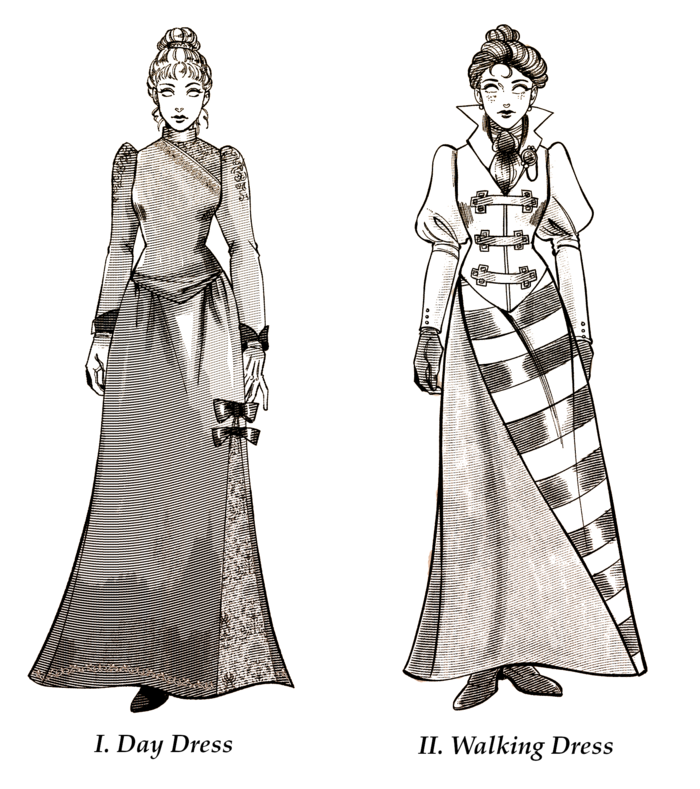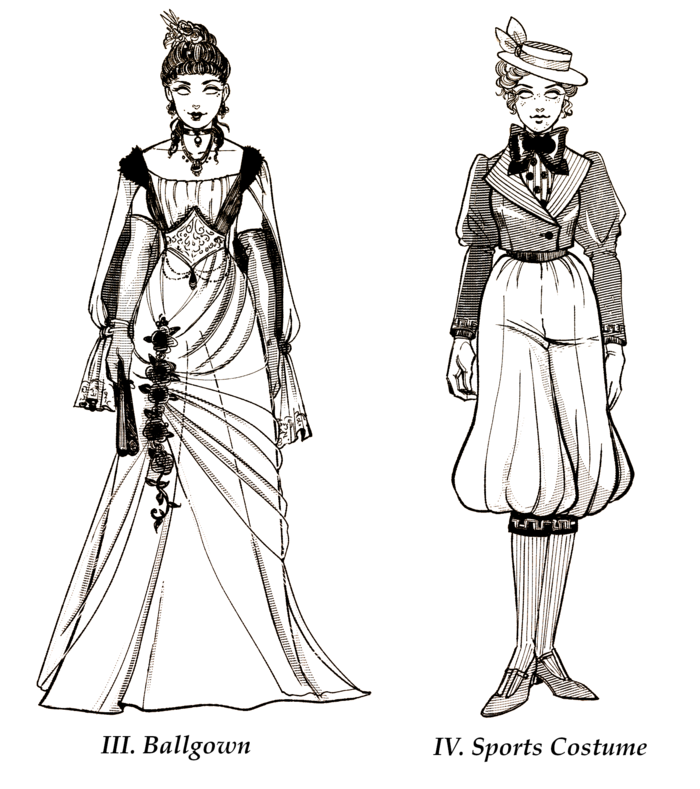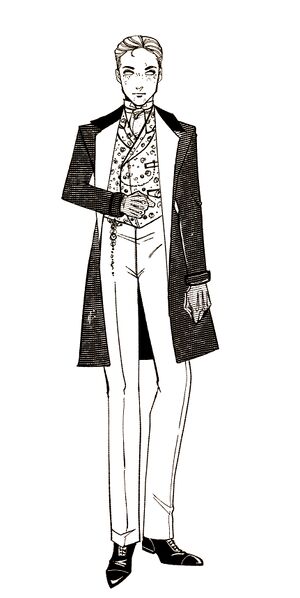Anaxi Fashion
From ThornsWiki
Contents
Galdor Fashion
For Anaxi galdori, wealth is displayed in the form of expensive and lavish clothing with many layers and finely-made materials. Innovations in textile production and clothing manufacture have made fashionable items more accessible to the masses. Thus, in order to distinguish themselves from the lower classes, galdori men and women follow a series of elaborate rules that dictate what is to be worn and when.
Both sexes wear high collars. With the changing of political tides, many of the most fashionable and forward-thinking galdori are taking cues from Mugrobi fabrics and styles, while retaining a distinctly Anaxi effect. There is also a burgeoning reactionary affinity for materials produced in Anaxas, and a greater interest in “traditional” styles.
Colorwise, women generally chose bright colors that match their eyes, hair, and jewelry. Jewel tones are very popular. Men tend to wear simpler clothing, with more severe colors—black, grey, red and white are popular. Male fashion is distinguished and refined. Patterns more ostentatious than a pinstripe are generally considered frowned upon, as are brighter colors, although neither is entirely unheard of.
The only colors to be avoided are powder and cerulean blue, the color of gated passive uniforms (deeper and richer blues are generally acceptable, though some still refuse to wear blue of any shade because of its associations). Green is a youthful color on both sexes, as it is the color for Brunnhold student uniforms. Young girls and boys are often dressed in pastels. There is little to distinguish the clothes of male and female children below the age of 3-4 years in terms of styles; the styles diverge only after children are a bit older.
Women's Fashion
For women, the currently fashionable silhouette puts an emphasis on an upright, statuesque figure with a narrow waist and wide, smooth hips. Although there are many articles written on the subject of corset ‘tightlacing’ and the injurious effects to health, for most women the stylish effect is achieved through the clever application of padding about the hip area. The fashion for voluminous sleeves further enhances the illusion of a smaller waist. Skirts are not wide, and bodices come lower than they did in previous years. Asymmetry is de rigueur, with many choosing to emphasize the “better” side of the body with embellishments, overlapped closures on jackets, and overskirt layers that gather to one side. Short trains are also popular for indoor wear; for travel or daily wear, the train may be buttoned up out of the way or left off entirely.
Increased participation and interest in sports and other healthful activities has led to a proliferation of specialized sporting costumes. The most divisive of these is the cycling suit, as it often consists of a split skirt or even trousers. These so-called “bloomers” are rarely as fitted as those worn by men, but tuck into high boots so as not to get caught in the gears of a bicycle. For all their critics, cycling has grown increasingly popular among young women; much of the opposition has quieted, but not all.
Undergarments have also streamlined to support this sleek, close-fitted look. The combination has come to often replace a separate chemise and drawers, to reduce bulk about the waist. Only one, perhaps two, petticoats are worn; depending on the desired effect, it may be worn under or over the corset. For more information, see “A Note on Unmentionables”.
Hats and gloves are always worn by ladies outside of the home; gloves are rarely removed unless necessary. Everyday hairstyles for galdori women have become simpler over the years, to support the increasingly elaborate hat styles. While previous years saw sleek, smooth coiffures, the current fashion is to loose, soft-edged chignon styles with a great emphasis on volume.
Men's Fashion
Menswear in Anaxas favors simpler styles and more severe colors. Men wear shirts with white collars (detachable, for ease of washing); the shirts themselves may be colored, but neutral colors are favored by most. For the particularly fashion-forward, especially among the young, unusual and eye-catching colors of both shirt and vest may be seen, often with a complimentary and coordinating silk tie, handkerchief, or pocket square. A jacket or blazer is worn over the vest. For daywear, this is usually of a plain, conservative color that matches the trousers. Eveningwear sees a greater variety in colors and textiles.
Trousers are worn at the natural waist, and are fitted to the waist, but not as closely as in the past. Trouser legs are straight and also less fitted than they were before, breaking over the top of the shoe; this has led to the need for braces to hold up the trousers. Many of these are quite elaborately decorated, and make a very popular, if intimate, gift from a sweetheart or spouse. They are worn underneath of the vest; it is inappropriate for them to be seen in most occasions. Trousers are rarely patterned, and colors tend to be dark. (Although this is by no means universal.)
A great emphasis is placed on comfortable, hygienic undergarments. A comfortable, easy-to-wash vest is worn next to the skin. Drawers are also often made of cotton, flannel or lambs’ wool, and usually come to the ankle. Shorter styles for use with knickerbockers for cycling and other sports may also be worn. Undergarments may come in all sorts of pleasing colors, usually pale so as not to show through the shirt. It is more common for drawers to come in strong colors than the undervest.
Hair for men is currently kept short and often worn styled away from the face. Facial hair is no longer in fashion, although is often seen on older men who are somewhat behind the times. Even still, full beards are unusual. Similarly, having hair that comes below the jawline is associated with older, unfashionable men.
Human Fashion
TBD.
Cosmetics
The fashionable woman’s toilette often includes the use of cosmetics, but for most respectable women (read: galdori) the look is subtle and not meant to attract notice to the application. Any high society lady accused of such a thing would strongly deny the use. A clear beeswax pomade to add slight shine and protect the lips from the elements, perhaps with a subtle amount of color; soot to darken the lashes; pearl powder to even the complexion, as needed—these are the common elements. These are made and purchased at the chemist’s, and often disguised as medicinal. On a day-to-day basis, most women wear no cosmetics at all. Ostentatious looks, in Anaxas, are associated with the lower races and are to be avoided.
A Note on Unmentionables
Of equal importance as one’s outerwear is, of course, one’s innerwear. Innerwear is made of easier-to-wash fabrics and protect the more expensive, difficult-to-clean fabrics of one’s attire from sweat, skin oils, and so on. Keep in mind that while the "lower" races may wear fewer layers, corsets are a universal undergarment. Any woman, galdor or wick or human, rich or poor, working or idle, who has any desire for respectability at all wears a corset; it serves much the same function as a modern, real-life bra.
Typically, for a galdori lady, this will consist of the following items (worn in this order, from inner-to-outer).
- Combinations - This is the first layer and goes next to the skin, made of a washable, comfortable fabric. This replaces the separate chemise and drawers, although these also are still worn. Combinations eliminate much of the bulk about one’s waist and are thus preferable under the current fashion. These may be plain, or have ribbons and lace trim, to the wearer’s fancy.
- Corset - Typically made of satin or cotton coutil. The current shape is rather straight across the front of the bust, and features a spoon busk that slightly rounds the stomach in profile while minimizing the appearance of the waist itself. The difference among classes will be in the quality of the corset, and the number owned. The practice of “tightlacing” — that is, lacing the corset very tightly to get as much of a waist reduction as possible — is strongly discouraged, and is only engaged in by a select few fashionable socialites.
- Corset-Cover/Camisole - This may also take the form of a slip, in which case it will also replace the first layer of petticoats. A camisole not only keeps the corset from wearing on the fabric of one’s bodice, but also prevents the line of the corset itself from being visible.
- Garters - These are used to hold up one’s stockings. They may be bands around the thigh, a belt with clips, or part of the corset itself.
- Petticoats - At this time, only one or two are worn. At least one is often flounced or pleated for fullness, and may be colored or white, trimmed with lace or plain.
- Bustle/Hip-padding - Wide skirts with full bustle cages are no longer de rigeur; the appearance of fullness at the hips (and a smaller waist) is created with any number of smaller pads, half-cages, flounces, etc. This depends on the desired style of skirt.
Brunnhold Uniforms
Seventen Uniforms
| |||||||||||||||||



